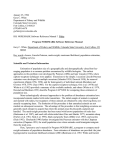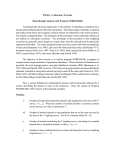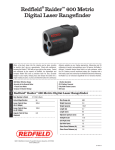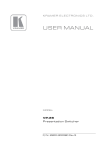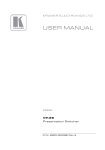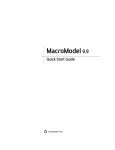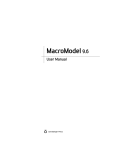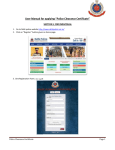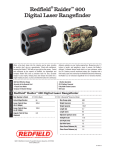Download Design features
Transcript
FW663 -- Laboratory Exercise Design of Mark-Resight Surveys with Program NOREMARK The objective of this exercise is to use Program NOREMARK to design a mark-resight survey. The Colorado Division of Wildlife is preparing to do a population estimate of mountain goats on Mount Evans. The mark-resight method is thought to be appropriate. The current best guess of the number of goats on Mount Evans is 200. An estimate of ±5% at " = 0.05 confidence is desired for this politically important project. Sighting heterogeneity is thought to be minimal, which implies which estimator is appropriate? The researcher in charge of this project figures the following costs for the various activities involved in the mark-resight estimate. a. To mark an individual with a radio collar costs $750. b. Helicopter time for the resighting surveys will cost $600/hour. c. Approximately 65% of the goats on Mount Evans can be seen in 3 hours of flight time, with complete coverage of the area. Increasing the flight time will not improve the proportion of the population seen, but would lead to duplicate counts. Decreasing the flight time would lower the proportion of animals counted proportionally, i.e., 1 ½ hours of flight time would mean about 32.5% of the population would be observed. Construct a table of 5-10 potential designs for this study, and recommend one of them as the optimal design, i.e., the strategy that provides the best precision per dollar spent and that is bracketed by other similar designs (thus demonstrating that your suggested optimal design is indeed optimal). What is your estimate of the cost of the goat survey to achieve a ±5% confidence interval? The following material is sections of the Program NOREMARK User’s Manual to help you use this program to answer the above questions. Design Option The fifth option of the main menu of Program NOREMARK allows the user to design a mark-resight survey. This design procedure uses simulation data generated by Neal (1990) based on the joint hypergeometric estimator. The user provides values of population size, number of sighting occasions, the expected proportion of the population that will be marked (capture probability), and the expected sighting probability. An example of the input screen follows. FW663 -- Design of Mark-Resight Surveys with Program NOREMARK 04/07/94 Page 2 10:00:39 64444444444444444444444444444444444444444444444444444444444444444444444444444447 5 Expected Results for a Proposed Design Using Interpolation 5 :444444444444444444444444444444444444444444444444444444444444444444444444444444< 5 5 5 Enter the expected values of for the parameters of the experiment: 5 5 (Press ESC to exit back to main menu.) 5 5 Guesstimate of population size: 450 5 5 Expected number of sighting occasions: 8 5 5 Expected proportion of population to be marked: 0.15 5 5 Expected proportion of population to be seen on each occasions: 0.65 5 5 5 5 5 5 5 5 5 5 5 5 5 5 5 5 5 5 5 The range of the input parameters is limited because results are determined by interpolating a database from Neal (1990). Population size must be in the range 50-500, number of occasions 5-20, capture probability 0.1-0.5, and sighting probability 0.1-0.7. Output consists of the estimated bias of the resulting estimate, and the confidence interval coverage and confidence interval length for " = 0.01, 0.05, 0.10, and 0.20. The following screen shows output from the above input. FW663 -- Design of Mark-Resight Surveys with Program NOREMARK 04/07/94 Page 3 10:00:39 64444444444444444444464444444444444444444444444444444444444744444444444444444447 5 Expected R5 Continue -- Do not save output 5rpolation 5 :444444444444444444445 File -- Output saved to a file 54444444444444444444< 5 5 Print -- Output saved to printer 5 5 5 Enter the expect944444444444444444444444444444444444448experiment: 5 5 (Press ESC to exit back to main menu.) 5 5 Guesstimate of population size: 450 5 5 Expected number of sighting occasions: 8 5 5 Expected proportion of population to be marked: 0.15 5 5 Expected proportion of population to be seen on each occasions: 0.65 5 5 5 5 Expected bias is 0.16% or 0.7 animals. 5 5 Expected 99% confidence interval is 18.4%, or 83.0 animals. 5 5 Expected 95% confidence interval is 13.9%, or 62.4 animals. 5 5 Expected 90% confidence interval is 11.6%, or 5 .1 animals. 5 5 Expected 80% confidence interval is 9.0%, or 40.3 animals. 5 5 Expected confidence interval coverage is (1-alpha)*100%. 5 5 5 5 5 5 5 5 5 5 The ESC key takes you back one menu screen. 5 5 You can get context-sensitive help with the F1 key. 5 944444444444444444444444444Top4444Bot4444Help4444PgUp4444PgDn4444Return4444ESC48 NOREMARK has generated the output and is now asking how to dispose of these results using the same menu as shown previously to continue, print, or file the output. Note in the output that the confidence interval length is reported as a percent of the estimate, and as the number of animals. Confidence interval length is the difference of the upper and low limits. For all the estimators in NOREMARK, the confidence intervals are not symmetric around the estimate. Often confidence interval length is reported as ± a percent of the estimate. This approach is not really valid for an asymmetric confidence interval. Thus, the values reported by NOREMARK are the total confidence interval length as a percent of the estimate, not just 1/2 of the confidence interval length. Confidence interval coverage of the JHE estimator was not found to differ from the expected 1 - " coverage rate, so coverage is reported as being (1 alpha)*100 percent. Estimator Simulation The final 4 options in the main menu of NOREMARK allow the user to simulate markresight surveys. This capability is useful in designing surveys when the parameters are outside the range of those allowed for the design option, or to compare the performance of estimators for the same input. As noted above, the design option only provides interpolated output for the joint hypergeometric estimator. With the 4 simulation options, you can simulate each estimator for a particular set of input values. The input for the 4 simulation options is basically the same for each estimator. Thus, FW663 -- Design of Mark-Resight Surveys with Program NOREMARK Page 4 I will only present the input for Bowden's estimator in detail, and mention differences for the other 3 estimators. The input screen for simulation of Bowden's estimator is shown below. 04/07/94 10:30:26 64444444444444444444444444444444444444444444444444444444444444444444444444444447 5 Monte Carlo Simulation of Joint Hypergeometric Estimator 5 :444444444444444444444444444444444444444444444444444444444444444444444444444444< 5 5 5 Enter the expected values of the parameters for the experiment: 5 5 Guesstimate of population size: 45 5 5 Expected number of sighting occasions: 4 5 5 Expected proportion of population to be marked: 0.30 5 5 Expected proportion of population to be seen on each occasions: 0.70 5 5 Alpha level for Confidence Interval Construction (0.01-0.50): 0.05 5 5 Number of replicates to simulate: 1000 5 5 Random number seed to initiate simulations: 4422654 5 5 5 5 5 5 5 5 5 5 5 5 5 5 5 5 5 5 5 5 The ESC key takes you back one menu screen. 5 5 You can get context-sensitive help with the F1 key. 5 944444444444444444444444444Top4444Bot4444Help4444PgUp4444PgDn4444Return4444ESC48 The input screen is requesting the size of the population, number of sighting occasions, expected proportion of the population that will be marked, and expected proportion of the population that will be resighted on each occasion. Next, the " level to use for confidence interval construction is entered. The number of simulations you request determines precision of results reported. If only a small number, such as 10, is requested, the program doesn't take long and a result that will be quite variable will be reported. To obtain more precise results, you should specify much larger values (such as the default of 1000), although time needed to simulate more replications can be substantial. The last input field specifies a random number seed to initialize the random number generator. The default value will change for each run because the default value is computed from the current date and time set in the computer. To generate identical data for 2 different estimators and hence achieve a better comparison of their performance, specify the same random number seed for each estimator. After you hit the Enter key on the last input field (or hit PgDn), the program displays a horizontal bar showing the percent of the simulations that have been completed. This display gives you a good idea of how long before the simulations will be completed. The following screen shows the output for the above input. FW663 -- Design of Mark-Resight Surveys with Program NOREMARK 04/07/94 Page 5 10:30:26 64444444444444444444464444444444444444444444444444444444444744444444444444444447 5 Monte Car5 Continue -- Do not save output 5stimator 5 :444444444444444444445 File -- Output saved to a file 54444444444444444444< 5 5 Print -- Output saved to printer 5 5 5 Enter the expect944444444444444444444444444444444444448eriment: 5 5 Guesstimate of population size: 45 5 5 Expected number of sighting occasions: 4 5 5 Expected proportion of population to be marked: 0.30 5 5 Expected proportion of population to be seen on each occasions: 0.70 5 5 Alpha level for Confidence Interval Construction (0.01-0.50): 0.05 5 5 Number of replicates to simulate: 1000 5 5 Random number seed to initiate simulations: 4422654 5 5 5 5 5 5 Simulation Results 5 5 5 5 Number of Valid Simulations: 1000 5 5 Expected Bias: 0.60% or 0.3 animals. 5 5 95% Conf. Interval Length: 29.43%, or 13.2 animals. 5 5 95% Conf. Interval Coverage: 95.90% 5 5 5 5 The ESC key takes you back one menu screen. 5 5 You can get context-sensitive help with the F1 key. 5 944444444444444444444444444Top4444Bot4444Help4444PgUp4444PgDn4444Return4444ESC48 The program reports the estimated bias of the estimate, the expected confidence interval length as a percent of the estimate and as the number of animals (total length -- see the discussion of these values in the design section), and the expected coverage based on the replicate simulations. For the immigration-emigration estimator, one additional input value is requested, i.e., the proportion of the population on the study area at the time of each sighting survey. For the Minta-Mangel estimator, the number of bootstraps to perform for each estimate is requested. For Bowden's estimator, the proportion of the marked animals that are identified is requested, allowing the user to evaluate the loss in precision of the estimator as a smaller and smaller proportion of the marked animals are individually identified. Output for all the estimators is the same, except that for the immigration-emigration estimator, the bias, confidence interval length, and confidence interval coverage are reported for both total population size and average daily population size. An example output for this estimator is shown in the following screen. FW663 -- Design of Mark-Resight Surveys with Program NOREMARK 04/07/94 Page 6 19:48:42 64444444444444444444464444444444444444444444444444444444444744444444444444444447 5 Monte Carl5 Continue -- Do not save output 5Estimator 5 :444444444444444444445 File -- Output saved to a file 54444444444444444444< 5 5 Print -- Output saved to printer 5 5 5 Enter the expect944444444444444444444444444444444444448eriment: 5 5 Guesstimate of total population size: 150 5 5 Expected proportion of population on study area: 0.90 5 5 Expected number of sighting occasions: 4 5 5 Expected proportion of population to be marked: 0.30 5 5 Expected proportion of population to be seen on each occasions: 0.70 5 5 Alpha level for Confidence Interval Construction (0.01-0.50): 0.05 5 5 Number of replicates to simulate: 1000 5 5 Random number seed to initiate simulations: 2922875 5 5 5 5 Simulation Results (Number of Valid Simulations Was 1000) 5 5 5 5 Total Population Daily Population 5 5 Expected Bias: 0.26% or 0.4 animals. 0.14% or 0.2 animals. 5 5 95% CI Length: 20.05%, or 30.1 animals. 17.43%, or 23.5 animals. 5 5 95% CI Coverage: 95.40% 93.40% 5 5 5 5 The ESC key takes you back one menu screen. 5 5 You can get context-sensitive help with the F1 key. 5 944444444444444444444444444Top4444Bot4444Help4444PgUp4444PgDn4444Return4444ESC48 Before starting a simulation with a large number of replicates (i.e., $500, the user should run the simulation with 5-10 replicates to see how much time the large simulation will take. For example, if a set of input parameters takes 2 minutes to complete 5 replications, then 1000 replications will take about 400 minutes, or 6.7 hours! You may want to reconsider whether you want to tie up your computer for the next 7 hours. The time that a simulation will take depends on the size of N (larger values take more time), capture probability (larger values take more time), sighting probability (larger values take more time), and number of occasions (more occasions take more time). Also, each of the 4 estimators require different amounts of computation, and thus take differing amounts of time to compute a single replication. Generally, Bowden's estimator is the fastest. The JHE and the IEJHE estimators require numerical optimization to compute the estimate, so take longer. The Minta-Mangel estimator uses a bootstrap procedure, so takes even longer, although the amount of time required depends on the number of iterations of the bootstrap procedure that are performed for each replication. In summary, evaluate the amount of time required before starting a big simulation. Questions for Discussion 1. Suppose that individual heterogeneity was thought to be important. Would simulating Bowden’s estimator with the Program NOREMARK simulator provide useful results? Hint: where in NOREMARK is information on individual heterogeneity entered when setting up simulations? FW663 -- Design of Mark-Resight Surveys with Program NOREMARK Page 7 2. Suppose the mountain goat population was 10 times larger. Would the population estimation survey cost 10 times as much? 3. What does a graph of cost versus precision of the estimate look like for each of the factors that can be manipulated in a mark-resight survey? Literature Cited Neal, A. K. 1990. Evaluation of mark-resight population estimates using simulations and field data from mountain sheep. M. S. Thesis, Colorado State Univ., Fort Collins. 198pp.







